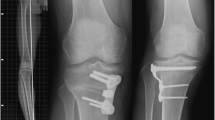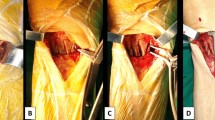Abstract
High tibial osteotomy (HTO) is a well-established technique for the treatment of medial osteoarthritis of the knee with varus malalignment. OWHTO has several advantages over CWHTO. However, several pitfalls should be avoided such as lateral hinge fracture, increased tibial slope angle, joint line obliquity, popliteal artery injury, delayed or nonunion. The surgical details of OWHTO surgical technique are described in this chapter.
Access this chapter
Tax calculation will be finalised at checkout
Purchases are for personal use only
Similar content being viewed by others
References
Seo SS, Kim OG, Seo JH et al. Complications and short-term outcomes of medial medial opening wedge high tibial osteotomy using a locking plate for medial osteoarthritis of the Knee. Knee Surg Relat Res. 2016;1;28(4):289–96.
Kuremsky MA, Schaller TM, Hall CC, et al. Comparison of autograft vs allograft in opening-wedge high tibial osteotomy. J Arthroplasty. 2010;25(6):951–7.
Takeuchi R, Ishikawa H, Kumagai K, et al. Fractures around the lateral cortical hinge after a medial openingwedge. high tibial osteotomy: a new classification of lateral hinge fracture. Arthroscopy. 2012;28:85–94.
Han SB, Lee DH, Shetty GM, et al. A “safe zone” in medial open-wedge high tibia osteotomy to prevent lateral cortex fracture. Knee Surg Sports Traumatol Arthrosc. 2013;21(1):90–5.
Ogawa H, Matsumoto K, Akiyama H. The prevention of a lateral hinge fracture as a complication of a medialopening wedge high tibial osteotomy: a case control study. Bone Joint J. 2017;99-B:887–93.
Turkmen F, Kacıra BK, Ozkaya M, et al. Comparison of monoplanar versus biplanar medial opening-wedge high tibial osteotomy techniques for preventing lateral cortex fracture. Knee Surg Sports Traumatol Arthrosc. 2017;25(9):2914–20.
Lee BS, Jo BK, Bin SI, et al. Hinge fractures are underestimated on plain radiographs after open wedge proximal tibial osteotomy; evaluation by computed tomography. Am J Sports Med. 2019;47(6):1370–5.
Marti CB, Gautier E, Wachtl SW, et al. Accuracy of frontal and sagittal plane correction in open-wedge high tibial osteotomy. Arthroscopy. 20:366–72.
Song EK, Seon JK, Park SJ. How to avoid unintended increase of posteriorslope in navigation-assisted open-wedge high tibial osteotomy. Orthopedics. 2007;30(10 Suppl):S127–31.
Noyes FR, Goebel SX, West J. Opening wedge tibial osteotomy; the 3-triangle method to correct axial alignment and tibial slope. Am J Sports Med. 2005;33(3):378–87.
Jo HS, Park JS, Byun JH, et al. The effects of different hinge positions on posterior tibial slope in medial open-wedge high tibial osteotomy. Knee Surg Sports Traumatol Arthrosc. 2018;26(6):1851–8.
Ogawa H, Matsumoto K, Ogawa T, et al. Effect of wedge insertion angle on posterior tibial slope in medial opening wedge high tibial osteotomy. Orthop J Sports Med. 2016;25;4(2):2325967116630748.
Hernigou P, Medevielle D, Debeyre J, et al. Proximal tibial osteotomy for osteoarthritis with varus deformity. A ten to thirteen-year follow-up study. J Bone Joint Surg Am. 1987;69:332–54.
Odenbring S, Egund N, Hagstedt B, et al. Ten-year results of tibial osteotomy for medial gonarthrosis. The influence of overcorrection. Arch Orthop Traua Surg. 1991;110(2):103–8.
Gaasbeek RD, Nicolaas L, Rijnberg WJ, et al. Correction accuracy and collateral laxity in open versus closed wedge high tibial osteotomy. A one-year randomised controlled study. Int Orthop. 2010;34(2):201–7.
Sim JA, Kwak JH, Yang SH, et al. Effect of weight-bearing on the alignment after open wedge high tibial osteotomy. Knee Surg Sports Traumatol Arthrosc. 2010;18:874–8.
Kim MS, Son JM, Koh IJ, et al. Intraoperative adjustment of alignment under valgus stress reduces outliers in patients undergoing medial opening-wedge high tibial osteotomy. Arch Orthop Traua Surg. 2017;137(8):1035–45.
Lee DH, Park SC, Park HJ, et al. Effect of soft tissue laxity of the knee joint on limb alignment correction in open-wedge high tibial osteotomy. Knee Surg Sports Trumatol Arthrosc. 2016;24(12):3704–12.
Ogawa H, Matsumoto K, Ogawa T, et al. Preoperative varus laxity correlates with overcorrection in medial opening wedge high tibial osteotomy. Arch Orthop Trauma Surg. 2016;136(10):1337–42.
Yasuda K, Majima T, Tsuchida T, et al. A ten- to 15-year followup observation of high tibial osteotomy in medial compartment osteoarthrosis. Clin Orthop Relat Res. 1992;282:186–95.
Babis GC, An KN, Chao EY, et al. Double level osteotomy of the knee: a method to retain joint-line obliquity. Clinical results. J Bone Joint Surg Am 2002;84-A(8):1380–8.
Terauchi M, Shirakura K, Katayama M, et al. Varus inclination of the distal femur and high tibial osteotomy. J Bone Joint Surg Br. 2002;84(2):223–6.
Saragaglia D, Nemer C, Colle PE. Computer-assisted double level osteotomy for severe genu varum. Sports Med Arthrosc Rev. 2008;16(2):91–6.
Schroter S, Nakayama H, Yoshiya S, et al. Development of the double level osteotomy in severe varus osteoarthritis showed good outcome by preventing oblique joint line. Arch Orthop Trauma Surg. 2019;139(4):519–27.
Coventry MB. Proximal tibial varus osteotomy for osteoarthritis of the lateral compartment of the knee. J Bone Joint Surg Am. 1987;69:32–8.
Chao EY, Neluheni EV, Hsu RW, et al. Biomechanics of malalignment. Orthop Clin North Am. 1994;25:379–86.
Nakayama H, Schroter S, Yamamoto C, et al. Large correction in opening wedge high tibial osteotomy with resultant joint-line obliquity induces excessive shear stress on the articular cartilage. Knee Surg Sports Trumatol Arthrosc. 2018;26(6):1873–8.
Shetty AA, Tindall AJ, Qureshi F, et al. The effect of knee flexion on the popliteal artery and its surgical significance. J Bone Joint Surg Br. 2003;85:218e222.
Kim J, Allaire R, Harner CD. Vascular safety during high tibial osteotomy: a cadaveric angiographic study. Am J Sports Med. 2010;38:810–5.
Anagnostakos K, Mosser P, Kohn D. Infections after high tibial osteotomy. Knee Surg Sports Traumatol Arthrosc. 2013;21(1):161–9.
Smith TO, Sexton D, Mitchell P, et al. Opening- or closing-wedged high tibial osteotomy; a meta-analysis of clinical and radiological outcomes. Knee. 2011;18(6):361–8.
Reischl N, Wahl P, Jacobi M, et al. Infections after high tibial open wedge osteotomy; a case control study. Arch Orthop Trauma Surg. 2009;129(11):1483–7.
Slevin O, Ayeni OR, Hinterwimmer S, et al. The role of bone void fillers in medial opening wedge high tibial osteotomy: a systematic review. Knee Surg Sports Traumatol Arthrosc. 2016;24(11):3584–98.
Lobenhoffer P, Agneskirchner JD. Improvements in surgical technique of valgus high tibial osteotomy. Knee Surg Sports Traumatol Arthrosc. 2003;11(3):132–8.
Goshima K, Sawaguchi T, Shigemoto K, et al. Large opening gaps, unstable hinge fractures, and osteotomy line below the safe zone cause delayed bone healing after open-wedge high tibial osteotomy. Knee Surg Sports Traumatol Arthrosc. 2019;27(4):1291–8.
El-Assal MA, Khalifa YE, Abdel-Hamid MM, et al. Opening-wedge high tibial osteotomy without bone graft. Knee Surg Sports Traumatol Arthrosc. 2010;18:961–6.
Kolb W, Guhlmann H, Windisch C, et al. Opening-wedge high tibial osteotomy with a locked low-profile plate. J Bone Joint Surg Am. 2009;91:2581–8.
Author information
Authors and Affiliations
Corresponding author
Editor information
Editors and Affiliations
Rights and permissions
Copyright information
© 2021 Springer Nature Singapore Pte Ltd.
About this chapter
Cite this chapter
Yoo, J.D., Park, J.S., Chung, J.Y., Park, M.G. (2021). Surgical Treatment and Overcoming Complications of High Tibial Osteotomy. In: Kim, J.G. (eds) Knee Arthroscopy. Springer, Singapore. https://doi.org/10.1007/978-981-15-8191-5_30
Download citation
DOI: https://doi.org/10.1007/978-981-15-8191-5_30
Published:
Publisher Name: Springer, Singapore
Print ISBN: 978-981-15-8190-8
Online ISBN: 978-981-15-8191-5
eBook Packages: MedicineMedicine (R0)




